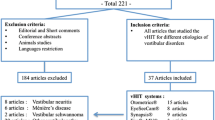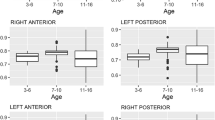Abstract
Video head impulse test (vHIT) aids to assess all three pairs of semi-circular canals (SCCs) separately and can be utilized to find out the exact site of lesion in any three SCCs by measuring vestibulo ocular reflex (VOR) gain. VOR gain value of vHIT has been used to diagnose different vestibular pathologies. Hence, it is important to establish the test–retest reliability of the VOR gain parameters before it could be administered to the patients. Therefore, the aim of the present study was to obtain VOR gain data, correlate all planes in both sides of head (right and left) and assess the test–retest reliability of VOR gain measure using vHIT in 25 normal young adult participants. Video head impulse test tests were carried out with prototype ICS impulse video goggles with a camera speed of 250 frames/s, recording motion of the right eye in all three planes (lateral, right anterior left posterior, left anterior right posterior) for all the participants. vHIT testing was repeated for all the participants after 15 days. Statistical analysis revealed that mean VOR gain for right horizontal canal was higher than the left horizontal canal; right anterior canal was higher than left anterior canal and left anterior was higher than right posterior canal. Horizontal canals have more gain compared to anterior and posterior canals. There was no significant difference between the VOR gain of session 1 and session 2 for each SCC.


Similar content being viewed by others
References
Bronstein AM, Gresty MA (1991) Compensatory eye movements in the presence of conflicting canal and otolith signals. Exp Brain Res 85(3):697–700
Ewald EJR (1892) Physiologische Untersuchungen ueber das Endorgan des Nervus octavus. Bergmann, Wiesbaden
Goldberg JM, Fernandez C (1971) Physiology of peripheral neurons innervating semicircular canals of the squirrel monkey. I. Resting discharge and response to constant angular accelerations. J Neurophysiol 34(4):635–660
Estes MS, Blanks RH, Markham CH (1975) Physiologic characteristics of vestibular first-order canal neurons in the cat. I. Response plane determination and resting discharge characteristics. J Neurophysiol 38(5):1232–1249
Baloh RW, Honrubia V, Konrad HR (1977) Ewald’s second law reevaluated. Acta Otolaryngol 83(5–6):475–479
Böhmer A, Henn V, Suzuki JI (1985) Vestibulo-ocular reflexes after selective plugging of the semicircular canals in the monkey—response plane determinations. Brain Res 326(2):291–298
Zhang Y, Chen S, Zhong Z, Chen L, Wu Y, Zhao G, Liu Y (2015) Preliminary application of video head impulse test in the diagnosis of vertigo. Lin Chung Er Bi Yan Hou Tou Jing Wai Ke Za Zhi 29(12):1053–1058
Martinez-Lopez M, Manrique-Huarte R, Perez-Fernandez N (2015) A puzzle of vestibular physiology in a Meniere’s disease acute attack. Case Rep Otolaryngol 2015:1–5
McGarvie LA, Curthoys IS, MacDougall HG, Halmagyi GM (2015) What does the dissociation between the results of video head impulse versus caloric testing reveal about the vestibular dysfunction in Ménière’s disease? Acta Otolaryngol 135(9):859–865
Blödow A, Heinze M, Bloching MB, von Brevern M, Radtke A, Lempert T (2014) Caloric stimulation and video-head impulse testing in Ménière’s disease and vestibular migraine. Acta Otolaryngol 134(12):1239–1244
Guerra JG, Pérez FN (2015) Reduction in posterior semicircular canal gain by age in video head impulse testing. Observational study. Acta Otorrinolaringol Esp 6519(15):00011–00014
Redondo-Martínez J, Bécares-Martínez C, Orts-Alborch M, García-Callejo FJ, Pérez-Carbonell T, Marco-Algarra J (2015) Relationship between video head impulse test (vHIT) and caloric test in patients with vestibular neuritis. Acta Otorrinolaringol Esp 6519(15):00142–00149
Murnane O, Mabrey H, Pearson A, Byrd S, Akin F (2014) Normative data and test–retest reliability of the SYNAPSYS video head impulse test. J Am Acad Audiol 25(3):244–252
Carhart R, Jerger J (1959) Preferred method for clinical determination of pure-tone thresholds. J Speech Hear Disord 24:330–345
McGarvie LA, MacDougall HG, Halmagyi GM, Burgess AM, Weber KP, Curthoys IS (2015) The video head impulse test (vHIT) of semicircular canal function–age-dependent normative values of VOR gain in healthy subjects. Front Neurol 8(6):154–160
Patterson JN, Bassett AM, Mollak CM, Honaker JA (2015) Effects of hand placement technique on the video head impulse test (vHIT) in younger and older adults. Otol Neurotol 36(6):1061–1068
Weber KP, Aw ST, Todd MJ, McGarvie LA, Curthoys IS, Halmagyi GM (2008) Head impulse test in unilateral vestibular loss: vestibulo-ocular reflex and catch-up saccades. Neurology 70(6):454–463
Viirre E, Tweed D, Milner K, Vilis T (1986) A reexamination of the gain of the vestibuloocular reflex. J Neurophysiol 56(2):439–450
Matiño-Soler E, Esteller-More E, Martin-Sanchez JC, Martinez-Sanchez JM, Perez-Fernandez N (2015) Normative data on angular vestibulo-ocular responses in the yaw axis measured using the video head impulse test. Otol Neurotol 36(3):466–471
Acknowledgments
The authors wish to thank the Director, AIISH for permitting us to carry out the study, the HOD-Audiology for permitting us to use the equipment in the Department. The authors also thank all the participants of this study.
Author information
Authors and Affiliations
Corresponding author
Ethics declarations
Conflict of interest
The authors report no conflict of interest.
Ethical statement
All the participants were informed initially about the study in detail and a written consent form was obtained from all the participants.
Rights and permissions
About this article
Cite this article
Bansal, S., Sinha, S.K. Assessment of VOR gain function and its test–retest reliability in normal hearing individuals. Eur Arch Otorhinolaryngol 273, 3167–3173 (2016). https://doi.org/10.1007/s00405-016-3951-3
Received:
Accepted:
Published:
Issue Date:
DOI: https://doi.org/10.1007/s00405-016-3951-3




